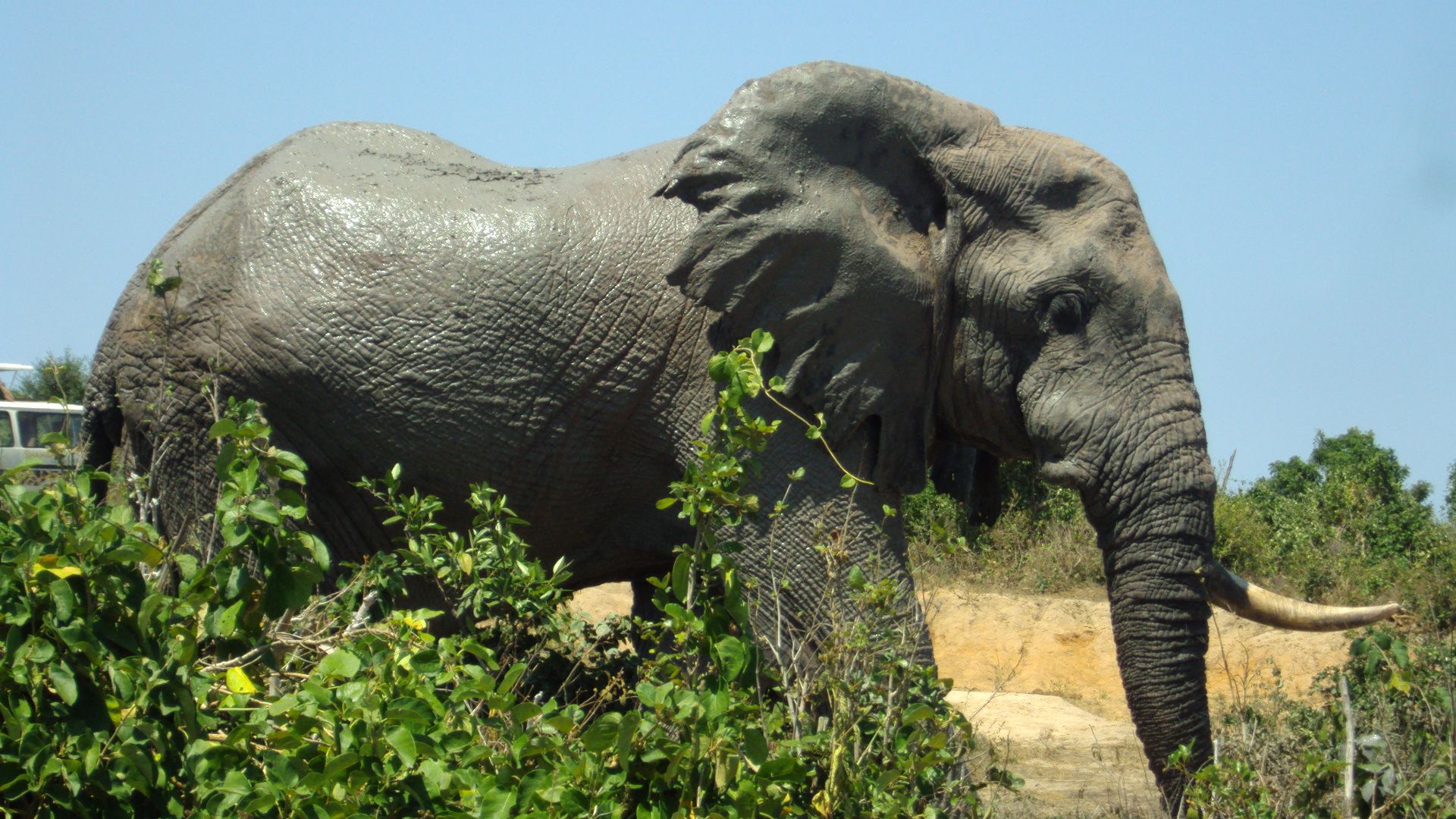By Gitonga Njeru
Mwaluganje Elephant Sanctuary Chairman Salim Mwanyongwe, is a happy man. The reserve he helps run is increasingly recognised as a conservation success story. And so is one of the ecotourism experiment’s most important economic activities: the production of elephant dung paper.
“The processed product is sold in Nairobi and exported to neighbouring Tanzania. The facility is community-owned, and the entire income generated goes to the community. Most of the country’s paper made from dung comes from here,” Mwanyongwe explained the product produced from elephant dung recovered from the area’s roads.
Mwaluganje Elephant Sanctuary was established in 1993 from leased land owned by about 4,000 farmers and landowners, and today is a community-owned 36-square-kilometre conservation area for elephants. Located approximately 45 kilometres southwest of Mombasa, the region contains a substantial elephant population, and the sanctuary is part of a key elephant corridor in the eastern part of the country.
“This area contains slightly more than 50 per cent of the country’s elephant population. This encompasses Shimba Hills Reserve and the expansive Tsavo Tsavo Parks, which are the physical size of Belgium,” explained Manyongwe.
“Incidents of illegal logging in protected areas around the coastal areas have been reduced as many farmers and land owners have been granted licences by the government to collect the dung. This has led to farmers having a source of income that does not harm the environment.”
Coastal Kenya, like parts of Tanzania, Mozambique and Somalia, once had an enormous coastal forest that stretched all along what is today regarded as the Swahili Coast – an area that sees regular, moisture-laden trade winds dumping rain on forested coastal escarpments. Deforestation throughout the region has increased the regularity of droughts and exacerbated floods. Mwanyongwe, through initiatives like the Mwaluganje elephant dung project, is hoping to reverse this trend.
“It is an industry that has not been fully tapped. There is little competition. Paper made from elephant dung is set to grow within the next few years,” said Benjamin Ndubi, a 30-year-old Nairobi-based entrepreneur who owns a facility in Mombasa that is specially designed to process elephant dung into paper.
Ndubi buys the dung directly from farmers, turns it into paper, and then processes and sells it.
Wildlife authorities only allow the practice in small quantities to minimise negative environmental effects. According to Bernard Agwanda, a mammalogist at the National Museums of Kenya, this is because elephant dung plays a vital role in the ecosystem.
“Elephant dung is vital for beetles and other insects to survive. If you misuse it, you will starve and destabilise the ecosystem. Elephants consume plants, so the energy has to flow back into the soil,” Agwanda said.
“So you have to use the dung wisely in small quantities, and that will allow enough time to go back into the soil. It is much better than telling farmers to clear their land and plant non-indigenous trees to produce paper. But these two issues differ scientifically and economically,” Agwanda explained.
Dung is widely used as a fuel in Kenya, with farmers collecting it all and burning it, releasing sequestered carbon back into the atmosphere. Keeping the carbon locked in, in the paper, is a better option, according to Ndubi, as farmers are encouraged to return a part of it to the soil.
Ndubi now worries about competition from wood cut from natural forests after Kenya recently reversed a ban on logging in the country.
“Paper from elephant dung is of very high quality. There is no physical difference between paper made from timber, and bamboo and that derived from elephant dung. But the recent declaration of the government lifting the ban on logging may reverse the gains made on conserving the environment. It also may affect my business in one way or the other. But on a positive note, forest cover in the country has increased, as many of us turn to innovative climate adaptation solutions,” he said.
Several of Ndubi’s customers are the parents of school children looking for speciality paper for their school projects; others are export-oriented companies.
“The demand for paper never goes down on any day… My customers include company offices, supermarkets and private shops. I also sell a small amount to clients in Tanzania and Rwanda,” Ndubi disclosed.
The process of turning dung into paper is simple, according to Ndubi. The dung fibres are first washed thoroughly in a vat to ensure they are clean. This removes unwanted particles from the fibres.
“After this extensive process, it is much similar to regular paper. Sometimes we mix or recycle with regular paper, but it’s not a requirement,” Ndubi said.
The dung is manufactured into quality tissue paper and 12 other paper products, according to Ndubi.
“It is a very sustainable way to manufacture paper without cutting down trees. People should embrace this technology as it goes a long way in the fight against climate change,” he said.
The paper-maker said there is a need to sensitise society to alternative ways of generating wood and timber products to prevent further environmental degradation and sustain elephant populations.
“Without elephants, the ecosystem would be so unfriendly. A lot can be benefited from elephants. In Asia, in countries such as Thailand and Sri Lanka, communities make paper from rhino waste. I visited those countries a few years ago. We can improve on our existing technologies by improving on them by borrowing from other societies,” Ndubi said.
Kenya’s former Environment Minister, Judy Wakhungu, the initiator of a much-celebrated plastics ban introduced by Kenya in 2017, said she was optimistic that the region – and the world – could still reverse much of the damage.
“I believe we can live in a world where there is no cutting of trees. There are many alternative ways of making paper, even from sugarcane waste and bamboo. Anything green is possible,” Wakhungu said.
She was one of the initiators of the ban on logging in 2016. The government recently lifted it.
“Society needs more education on sustainable environment practices,” said Ndubi, who would like more people to be aware of their choices, particularly when it comes to wood products as well as sustainable paper and his elephant dung products. The government’s recent move to allow logging is a wrong decision. But this technology can employ many people if fully utilised.”
Regarding sustainable practices, including support for environmental initiatives like ecotourism and the protection of trees, the Kenyan government has found that communities have to be an integral part of conservation efforts. Currently, based on data from the Ministry of Environment, the country’s forest cover stands at 12 %. According to experts, at least a third of a country should be covered by forest.
Mwaluganje is helping to accelerate this trend. Landowners have ensured that trees are protected, offering food and shelter to increasing numbers of elephants moving through the sanctuary. The elephant dung paper is an essential component of the park’s income, helping to pay leases to farmers and landowners, ensuring they continue protecting the ecosystem. According to the park chairman, the paper is a more viable option than others.
“They are more affordable than normal paper, and they can be potentially recycled and used as paper again,” Mwanyongwe said.
The effectiveness of the Mwaluganje model suggests that community ecotourism could be effective elsewhere in the country – and in other parts of Africa, according to Mwanyongwe.
Economic benefits for the local community include tourism returns on gate fees and other tourist income, in addition to the sales of elephant dung paper and honey – another community initiative.
“Obviously, land owners are paid for leasing their land,” Mwanyongwe said.
Philip Katana is a land owner who has leased 32 of his 62 acres of land to Mwaluganje.
“Mwaluganje is a big story. We at first thought when we lease our land, it is being taken away. We were at first hesitant, but later, we learned of the benefits, and we eventually embraced it. We get money from most of the sanctuary activities, including gate fees, we get paid annually and obviously (keep) our land. But we also get high returns on a regular basis from the manufacture and sale of paper products from elephant dung. It’s a peaceful existence with elephants. The economic returns from all these activities are satisfactory,” Katana said.
According to data collected in 2021 by the African Wildlife Foundation, there are currently 36,280 elephants living in Kenya. Slightly more than half of the country’s elephant population is to be found in the coastal region.
Kenya has seen its elephant population almost double since 2014. According to experts, this is because incidences of poaching have gone down due to effective security and monitoring systems. It is also due to better management of human-wildlife conflict.
The doubling of elephant numbers and poaching incidences gradual decrease is owed to the fact that the government has established new ways of dealing with poachers – including the use of drones and short message service communication as well as artificial intelligence.
“The CITES ban has partially contributed to the current growth of elephant populations in the country. Also, Kenya’s stand on ivory trade,” explained mammologist, Agwanda.
CITES, or the Convention of International Trade of Endangered Species of Wild Flora and Fauna, is a multilateral treaty by the United Nations to protect endangered plants and animals. It consists of more than 185 nations that are signatories to the treaty that took effect on July 1st 1975.
“The Convention of International Trade of Endangered Species of Wild Flora and Fauna (CITES) banned international trade in ivory,” Agwanda said.
Kenya banned Ivory trade in 1989 as a member of CITES. That same year, the country destroyed over twelve tonnes of its stockpile of ivory – collected from natural deaths and destroyed rogue elephants – and called for an international ban on the trade of ivory.
In April 2016, the country destroyed another 105 tonnes of ivory and the country called for a total ban on the ivory trade during the 2016 CITES Conference in Johannesburg.
But Agwanda points out that so far, the biggest threat to elephant survival is climate change. Drought was responsible for the deaths of hundreds of elephants in Tsavo last year alone.
Building tree cover by protecting swathes of coastal forest and the elephants they feed and protect is one solution. The other is the sale of the elephant dung paper that the Mwaluganje community produces – so they get to benefit from protecting both the trees and the elephants.
“This is a good way of dealing with human and wildlife conflicts. Incidents at Mwaluganje are minimal. The elephant numbers continue to grow,” Mwanyongwe said.
bird story agency
The Mwaluganje Elephant Sanctuary in Kenya, chaired by Salim Mwanyongwe, is lauded for its conservation efforts and innovative production of elephant dung paper. Established in 1993 on leased land from 4,000 farmers, the 36-square-kilometre sanctuary aids in conserving a significant part of Kenya's elephant population. The community-owned project generates income for locals by selling dung paper domestically and internationally, notably in Nairobi and Tanzania.
Elephant dung paper production has environmental benefits, reducing illegal logging and providing a sustainable income source that doesn't harm the ecosystem. This initiative exemplifies how community ecotourism can effectively support conservation and improve local livelihoods.
Despite its success, concerns arise due to Kenya's recent reversal of a logging ban, potentially impacting conservation gains. Entrepreneur Benjamin Ndubi, who processes and sells the dung paper, emphasizes its high quality and sustainability. He advocates for greater societal awareness and governmental support for innovative, eco-friendly practices.
Moreover, Kenya's elephant population has nearly doubled since 2014 due to effective anti-poaching measures and better human-wildlife conflict management. The sale of elephant dung paper, along with increased forest cover and effective community engagement, aids in addressing the challenges posed by climate change and supports elephant conservation efforts.
Overall, Mwaluganje's model of combining conservation with economic benefit through sustainable practices serves as a promising blueprint for similar initiatives across Africa.






